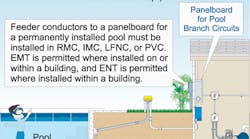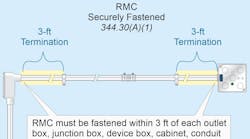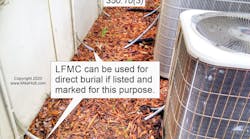Q. I need to run a feeder to a pool house panel. What are the wiring methods required for this type of installation?
A. The requirements are contained in 680.25, and read as follows:
Feeder conductors to panelboards containing permanently installed pool, outdoor spa, or outdoor hot tub equipment circuits must be installed in rigid metal conduit, intermediate metal conduit, liquidtight flexible nonmetallic conduit, or PVC conduit. Electrical metallic tubing is permitted where installed on or within a building, and electrical nonmetallic tubing is permitted where installed within a building. An Exception to this requirement allows branch circuits for permanently installed pool, outdoor spa, or outdoor hot tub equipment to originate from an existing panelboard, where the existing feeder contains an equipment grounding conductor within the outer sheath of a cable.
An insulated copper or aluminum equipment grounding conductor must be installed with the feeder conductors between the grounding terminal of the pool, outdoor spa, or outdoor hot tub equipment panelboard and the grounding terminal of the applicable service equipment. This feeder equipment grounding conductor must be sized according to 250.122, but be no smaller than 12 AWG.
Where a feeder is run to a separate building or structure to supply permanently installed swimming pool, outdoor spa, or outdoor hot tub equipment, an insulated equipment grounding conductor must be installed with the feeder conductors to the disconnecting means at the separate building or structure [250.32(B)].





